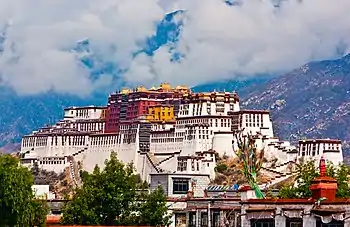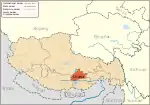| Pabonka Hermitage | |
|---|---|
Tibetan transcription(s) Wylie transliteration: Pha bong kha Chinese transcription(s) Traditional: 帕邦喀 Simplified: 帕邦喀 | |
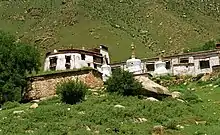 Pabonka Hermitage | |
| Religion | |
| Affiliation | Tibetan Buddhism |
| Festivals | Six-day Avalokiteśvara fasting Losar ritals Sixteen day fourth Tibetan month fasting rituals “Sixth-Month Fourth-Day” pilgrimage |
| Leadership | Part of Sera Monastery today. |
| Location | |
| Location | Mount Parasol, Lhasa Prefecture, Tibet, China |
| Country | China |
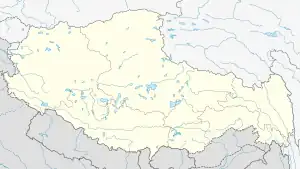 Location within Tibet | |
| Geographic coordinates | 29°43′11″N 91°7′06″E / 29.71972°N 91.11833°E |
| Architecture | |
| Founder | Songtsen Gampo |
| Date established | 7th century |
Pabonka Hermitage (Pha bong kha), also written Pawangka,[1] is a historical hermitage, today belonging to Sera Monastery, about 8 kilometres northwest of Lhasa in the Nyang bran Valley on the slopes of Mount Parasol (Dbu gdugs ri) in Tibet.
Founded by Songtsen Gampo in the 7th century, it is currently the largest and most important of the Sera hermitages and is the starting point for the “Sixth-Month Fourth-Day” (Drug pa tshe bzhi) of the Sera Mountain Circumambulation Circuit (Se ra’i ri ’khor) pilgrimage.
.jpg.webp) Pabonka Hermitage
Pabonka Hermitage Looking towards Lhasa from Pabonka Hermitage
Looking towards Lhasa from Pabonka Hermitage.jpg.webp) prayer flags
prayer flags.jpg.webp)
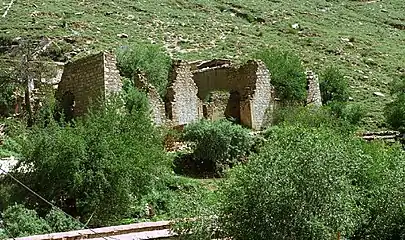 Ruins
Ruins.jpg.webp)
.jpg.webp)
Footnotes
- ↑ Gyurme Dorje (1999). Tibet Handbook with Bhutan (2nd ed.). Bath, UK: Footprint Handbooks. p. 122. ISBN 978-1-900949-33-0.
References
- Gyurme Dorje. (1999). Footprint Tibet Handbook with Bhutan. 2nd Edition. Footprint Handbooks Ltd., Bristol, England. ISBN 1-900949-33-4. In USA published by NTC/Contemporary Publishing. Chicago. ISBN 0-8442-2190-2.
- Dowman, Keith. (1998). The Power-places of Central Tibet: The Pilgrim's Guide. Routledge & kegan Paul, London. ISBN 0-7102-1370-0
| Part of a series on |
| Tibetan Buddhism |
|---|
 |
External links
This article is issued from Wikipedia. The text is licensed under Creative Commons - Attribution - Sharealike. Additional terms may apply for the media files.
